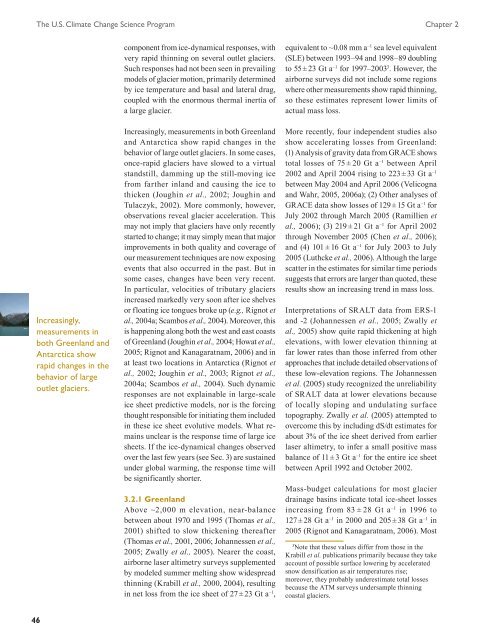Book 2.indb - US Climate Change Science Program
Book 2.indb - US Climate Change Science Program
Book 2.indb - US Climate Change Science Program
- No tags were found...
You also want an ePaper? Increase the reach of your titles
YUMPU automatically turns print PDFs into web optimized ePapers that Google loves.
The U.S. <strong>Climate</strong> <strong>Change</strong> <strong>Science</strong> <strong>Program</strong> Chapter 2Increasingly,measurements inboth Greenland andAntarctica showrapid changes in thebehavior of largeoutlet glaciers.component from ice-dynamical responses, withvery rapid thinning on several outlet glaciers.Such responses had not been seen in prevailingmodels of glacier motion, primarily determinedby ice temperature and basal and lateral drag,coupled with the enormous thermal inertia ofa large glacier.Increasingly, measurements in both Greenlandand Antarctica show rapid changes in thebehavior of large outlet glaciers. In some cases,once-rapid glaciers have slowed to a virtualstandstill, damming up the still-moving icefrom farther inland and causing the ice tothicken (Joughin et al., 2002; Joughin andTulaczyk, 2002). More commonly, however,observations reveal glacier acceleration. Thismay not imply that glaciers have only recentlystarted to change; it may simply mean that majorimprovements in both quality and coverage ofour measurement techniques are now exposingevents that also occurred in the past. But insome cases, changes have been very recent.In particular, velocities of tributary glaciersincreased markedly very soon after ice shelvesor floating ice tongues broke up (e.g., Rignot etal., 2004a; Scambos et al., 2004). Moreover, thisis happening along both the west and east coastsof Greenland (Joughin et al., 2004; Howat et al.,2005; Rignot and Kanagaratnam, 2006) and inat least two locations in Antarctica (Rignot etal., 2002; Joughin et al., 2003; Rignot et al.,2004a; Scambos et al., 2004). Such dynamicresponses are not explainable in large-scaleice sheet predictive models, nor is the forcingthought responsible for initiating them includedin these ice sheet evolutive models. What remainsunclear is the response time of large icesheets. If the ice-dynamical changes observedover the last few years (see Sec. 3) are sustainedunder global warming, the response time willbe significantly shorter.3.2.1 GreenlandAbove ~2,000 m elevation, near-balancebetween about 1970 and 1995 (Thomas et al.,2001) shifted to slow thickening thereafter(Thomas et al., 2001, 2006; Johannessen et al.,2005; Zwally et al., 2005). Nearer the coast,airborne laser altimetry surveys supplementedby modeled summer melting show widespreadthinning (Krabill et al., 2000, 2004), resultingin net loss from the ice sheet of 27 ± 23 Gt a –1 ,equivalent to ~0.08 mm a –1 sea level equivalent(SLE) between 1993–94 and 1998–89 doublingto 55 ± 23 Gt a –1 for 1997–2003 3 . However, theairborne surveys did not include some regionswhere other measurements show rapid thinning,so these estimates represent lower limits ofactual mass loss.More recently, four independent studies alsoshow accelerating losses from Greenland:(1) Analysis of gravity data from GRACE showstotal losses of 75 ± 20 Gt a –1 between April2002 and April 2004 rising to 223 ± 33 Gt a –1between May 2004 and April 2006 (Velicognaand Wahr, 2005, 2006a); (2) Other analyses ofGRACE data show losses of 129 ± 15 Gt a –1 forJuly 2002 through March 2005 (Ramillien etal., 2006); (3) 219 ± 21 Gt a –1 for April 2002through November 2005 (Chen et al., 2006);and (4) 101 ± 16 Gt a –1 for July 2003 to July2005 (Luthcke et al., 2006). Although the largescatter in the estimates for similar time periodssuggests that errors are larger than quoted, theseresults show an increasing trend in mass loss.Interpretations of SRALT data from ERS-1and -2 (Johannessen et al., 2005; Zwally etal., 2005) show quite rapid thickening at highelevations, with lower elevation thinning atfar lower rates than those inferred from otherapproaches that include detailed observations ofthese low-elevation regions. The Johannessenet al. (2005) study recognized the unreliabilityof SRALT data at lower elevations becauseof locally sloping and undulating surfacetopography. Zwally et al. (2005) attempted toovercome this by including dS/dt estimates forabout 3% of the ice sheet derived from earlierlaser altimetry, to infer a small positive massbalance of 11 ± 3 Gt a –1 for the entire ice sheetbetween April 1992 and October 2002.Mass-budget calculations for most glacierdrainage basins indicate total ice-sheet lossesincreasing from 83 ± 28 Gt a –1 in 1996 to127 ± 28 Gt a –1 in 2000 and 205 ± 38 Gt a –1 in2005 (Rignot and Kanagaratnam, 2006). Most3Note that these values differ from those in theKrabill et al. publications primarily because they takeaccount of possible surface lowering by acceleratedsnow densification as air temperatures rise;moreover, they probably underestimate total lossesbecause the ATM surveys undersample thinningcoastal glaciers.46






